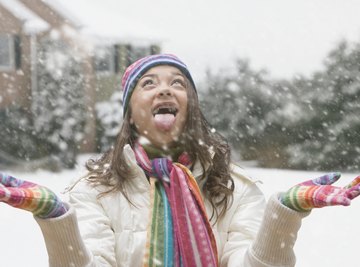
Every winter, icy precipitation falls from the sky and appears to accumulate as layers of fluffy, white powder. Snowy weather can cancel school and gives most adults a good reason to stay home from work, but it also makes driving particularly treacherous and can actually snap power lines and trees due to its weight. The truth is, however, that many things need to happen within the atmosphere for snow to even form.
Freezing Temperatures
It must be below freezing -- 32 degrees Fahrenheit or zero degrees Celsius -- in the clouds and near the ground for snow to form. Scientists are still working to gain a better understanding of severe winter weather, as changes in atmospheric conditions and even the smallest variations in temperature can actually determine whether winter precipitation will fall as snow, sleet, freezing rain or even regular rain.
Atmospheric Lift
Lift is a winter weather term that describes how a separate element is needed to raise moist air to form clouds and cause frozen precipitation. In most cases, snow is caused when warm air collides with cold air and is forced to rise over the frigid air mass. That boundary between the warm and cold air is called a front, a term you hear a meteorologist use quite frequently in forecasting winter weather.
"Lake Effect"
If you've ever wondered why most heavy snowfalls occur near the Great Lakes, it's for a very good reason. Moisture is an essential element needed to form clouds and winter precipitation, and tremendously cold air blowing across a very large, warm body of water is a recipe for a big snowstorm. This is often described as "Lake Effect snow."
Climate Change
Large-scale winter storm systems have steadily tracked to the north in the United States over the last 50 years. According to the U.S. Climate Impacts Report conducted by the United States Global Change Research Program, this is actually due to global warming because hotter air can hold more moisture, allowing storms to eventually dump massive amounts of snow over concentrated areas once the temperature falls.
Jet Stream
According to The Weather Channel, the proper positioning of the jet stream is one of the final ingredients for a snow event. This involves a relatively warm air mass accompanied by flowing moisture from the south, which meets cold air flowing down from the north. When the temperature drops at or below freezing in the atmosphere, it ensures that freezing or frozen precipitation will fall.
References
About the Author
Stephanie Sigafoos has been writing since 2004 and works as an online news producer. Her work and bylines have appeared on websites like tv.com and others. Sigafoos holds a Bachelor of Science in electronic media from Kutztown University.
Photo Credits
Jose Luis Pelaez Inc/Blend Images/Getty Images
